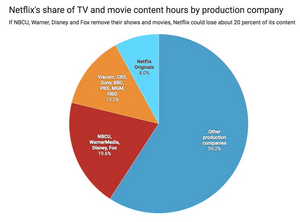Netflix, Inc.
 Logo used since 2014 | |
 Headquarters in Los Gatos, California, 2019 | |
| Netflix | |
| Type | Public company |
| |
| Industry | |
| Founded | August 29, 1997 |
| Founders | |
| Headquarters | , U.S. |
Key people |
|
| Products |
|
| Services |
|
| Revenue | |
| Total assets | |
| Total equity | |
Number of employees | 12,800 (2022) |
| Divisions |
|
| Subsidiaries |
|
| Website | Template:EditAtWikidata |
| Footnotes / references [1] | |
Netflix, Inc. provides entertainment services. It offers TV series, documentaries, feature films, and mobile games across various genres and languages. The company provides members the ability to receive streaming content through a host of internet-connected devices, including TVs, digital video players, television set-top boxes, and mobile devices. It also provides DVDs-by-mail membership services in the United States. As of 2023, the company has approximately 232 million paid members in 190 countries. Netflix, Inc. was incorporated in 1997 and is headquartered in Los Gatos, California.
The history[2] edit edit source
Netflix was founded in 1997 by Americans Reed Hasting and Marc Randolph. In 1999 Netflix offered online subscription service. Netflix sent DVDs from more than 100 distribution centres. The problem they had was the number of DVDs is limited and there was a huge storage requirement.
In 2006, Netflix invested 1 million to improve its recommendation system by 10%.
In 2007, Netflix started to offer streaming on the devices through the internet therefore, Netflix needed to partner with electronics products manufactures such as video game consoles X-box and Blu-ray Disc player.
In 2010 Netflix introduced streaming-only plan in the US and Canada.
In 2013, house of cards launched and Netflix started to create it original content.
Mission statement edit edit source
The mission of Netflix to entertain the world. Their core strategy is to grow business globally within the parameters of operating margin target. Netflix strive to continuously improve the customers’ experience by offering appealing content that satisfies them and attracts new members, as well as helping the members choose content more easily.[3]
Netflix started to offer ads since the end of 2022. Their goal is to build connection via gaining new user from other brands as well as building a new source of revenue. It sets 40 million ad user goal for Q3 2023.[4]
Products edit edit source
Netflix, mainly known for its digital streaming platform, offers a wide range of movies, TV series, documentaries, and original content. While Netflix doesn't produce physical products like tangible goods, it does produce and distribute various forms of media content as part of its service.
o Netflix is renowned for its original TV shows in a variety of genres, including drama, comedy, science fiction, fantasy, crime, and more. Examples include the television shows "Stranger Things," "The Crown," "Outerbanks" "Narcos" “13 reasons why”, “You”.
o Original Films: From blockbuster-style blockbusters to indie and foreign productions, Netflix creates and distributes original motion pictures. There are several well-known instances, such as "Bird Box," "The Irishman," "Extraction” etc which had an estimated 90M views in its first 4 weeks.
o Documentaries: Netflix has a huge selection of documentaries, including films and TV shows, on a variety of subjects, including true crime, the environment, technology, and history. Several notable documentaries exist, such as "Diagnosis?" "Tiger King" and "The Social Dilemma."
o Animation: Netflix has made investments in both children's and adult-oriented animated TV shows and films. Ones that come to mind are "BoJack Horseman," "Big Mouth," and "Klaus."
o Comedy Specials: Netflix has established itself as a major source of stand-up comedy specials from a variety of established and upcoming comedians. On the platform, specials from comedians like Dave Chappelle, Hannah Gadsby, and Ali Wong have been made available.
o Interactive Content: Netflix has also experimented with interactive content, letting viewers make decisions that affect the plot of some programmes, such "Black Mirror: Bandersnatch."
o International Content: Netflix provides access to a huge selection of foreign films, TV series, and documentaries. The international appeal of some non-English language television programmes like "Dark" and "Money Heist" have had enormous successes.
A huge part of Netflix’s success stems from their shift to creating more original content. Started in 2013, Netflix offers series producers and showrunners advance contracts to create a complete season or two at a time when networks typically accepted shows based on pilots that matched specific benchmarks. In contrast to broadcast and cable TV's once-a-week instalment schedule, Netflix began releasing full seasons of well-known TV shows at once, effectively starting the binge-watching trend.

Business Segments edit edit source
Netflix operates as one operating segment. Their revenues are primarily derived from membership fees for streaming services. Netflix have approximately 231 million paid memberships in over 190 countries.[3]
Fee structure: 3 different memberships
1. Standard with ads: $6.99/month with 4-5 minutes of ads per hour at 720p resolution
2. Standard: $15.49/month
3. Premium: $19.99/month allowing 4 screens/devices
Gaming edit edit source
Netflix games are a collection of mobile games that are available to subscribers at no extra cost. Netflix hired Mike Verdu as the vice president of game development and released mobile games on both android and IOS uses in Nov 2021. Verdu was interested in cloud gaming options and will continue to expand their gaming portfolio. Netflix acquired some studios that develop games such as Night School Studio. By October 2022, Netflix had 35 games and more than 55 in development. There were on average 1.7 million uses a day which is less than 1% of the streaming service users in 2022.
Competition edit edit source
Streaming edit edit source
There is fierce rivalry for Netflix's market share and subscriber growth in the streaming and entertainment sectors from a wide range of businesses, both established and up-and-coming.
Traditional Media Companies edit edit source
To actively compete with Netflix, well-known media conglomerates and studios including Disney, WarnerMedia, and NBCUniversal have introduced their own streaming services (Disney+, HBO Max, Peacock). These businesses have enormous collections of popular content, including franchises, that can draw Netflix users away.
Tech Giants edit edit source
Companies like Amazon (Prime Video) and Apple (Apple TV+), who have significant financial resources and a large worldwide user base, have entered the streaming business. Their capacity to leverage of their current platforms and provide packaged services could pose a challenge to Netflix's position in the market.
Regional Players edit edit source
Numerous regional and specialised streaming services target particular demographics or geographical areas. These websites, like Hulu in the US, BBC iPlayer in the UK, and Hotstar in India, offer localised material and can draw viewers who value regional programming.
Emerging Competitors edit edit source
Numerous regional and specialised streaming services target particular demographics or geographical areas. These websites, like Hulu in the US, BBC iPlayer in the UK, and Hotstar in India, offer localised material and can draw viewers who value regional programming.
Original Content Production edit edit source
HBO, Amazon Prime Video, and Disney+ edit edit source
These platforms make significant investments in the creation of original content with the goal of producing appealing and limited-edition series and films to draw in members. They can produce high-quality material that can compete with Netflix's original programming thanks to their solid financial foundation.
User-Generated Content Platforms edit edit source
YouTube and other platforms for user-generated video may draw viewers away from professionally created content, which could have an effect on viewership and subscription growth.
Technological Shifts edit edit source
Emerging technologies like augmented reality (AR) and virtual reality (VR) could alter the way audiences consume entertainment. Companies that successfully leverage these technologies to create immersive experiences could challenge Netflix's dominance.
Team [5] edit edit source
Leadership edit edit source
Co-Founder & Executive Chairman edit edit source

Reed Hastings co-founded Netflix in 1997. Reed received an MSCS in AI from Stanford University in 1988 after briefly working as a maths teacher. In 1991, Reed founded Pure Software, which made tools for software developers before co-founding Netflix.
Reed is an active educational philanthropist and served on the California State Board of Education from 2000 to 2004. He is currently on the board of several educational organizations including KIPP and Pahara. Reed is also a board member of The City Fund.
Co-CEO edit edit source

Greg Peters is Co-CEO of Netflix. Previously Greg served as Chief Operating Officer and Chief Product Officer. Earlier, Greg was International Development Officer for Netflix, responsible for the global partnerships with consumer electronics companies, Internet service providers and multi-channel video programming distributors that enable Netflix to deliver movies and TV shows across a full range of devices and platforms.
Co-CEO edit edit source

Ted Sarandos is co-CEO of Netflix. Ted has significant executive management and leadership experience and is integral to developing corporate strategy. He has been responsible for all content operations since 2000, and led the company's transition into original content production that began in 2013 with the launch of the series ‘House of Cards,’ ‘Arrested Development’ and ‘Orange Is the New Black,’ among numerous others.
Ted is recognized in the industry as an innovator in film and television acquisition, distribution, and production, and was named one of Time Magazine’s 100 Most Influential People of 2013.
Chief Financial Officer edit edit source

Spencer Neumann was named CFO of Netflix in January of 2019. Previously, he served as Activision Blizzard’s CFO from May 2017. Prior to that, Spencer held a number of positions of increasing responsibility at The Walt Disney Company, most recently serving as the CFO and executive vice president of Global Guest Experience of Walt Disney Parks and Resorts, from 2012 until May 2017. From 2005 to 2012, Spencer worked at the private equity firms of Providence Equity Partners and Summit Partners.
Chief Content Officer edit edit source

Bela Bajaria was named Chief Content Officer in 2023. Bela was named Head of Global TV in 2020, overseeing English language and local language scripted and unscripted series around the world. Previously, she oversaw local language originals, original series across Europe, the Middle East, Türkiye, Africa, India, Asia, and Latin America. In this role, she managed the teams behind shows such as 'La Casa de Papel' (Spain), 'The Witcher' (Poland), 'Sacred Games' (India), 'Squid Game' (Korea), 'Blood & Water' (South Africa), and 'Sintonia' (Brazil). Bela joined Netflix in 2016 to lead Netflix's push into unscripted programming including the critically acclaimed 'Queer Eye,' 'Nailed It!' and 'Tidying Up with Marie Kondo.' She was previously President of Universal Television.
Chairman of Netflix Film edit edit source

Scott Stuber is the Chairman of Netflix Films where he oversees the development, production and acquisition of the Netflix film slate. Recent hits under Scott’s supervision include: 'Glass Onion: A Knives Out Mystery,' 'All Quiet on the Western Front,' 'The Adam Project,' 'The Gray Man,' Academy Award and BAFTA-winning 'The Power of the Dog,' Academy Award nominee 'Don’t Look Up,' Martin Scorsese’s 'The Irishman,' Academy Award winner 'Marriage Story,' 'Red Notice,' and three-time Academy Award winner 'ROMA.' Prior to Netflix, he founded and ran Bluegrass Films, which produced such hits as 'Ted,' 'Central Intelligence,' and 'Safe House.'
Ownership structure edit edit source
The breakdown of the major holders of Netflix is as follows: 83.88% of shares are held by institutions, whilst 1.35% of shares are held by all insiders. There are 2,642 different institutions holding shares. [6] The top 3 individuals with the greatest amount of insider shares are Leslie J. Kilgore, David Hyman and Greg Peters.

- 48.02% Mutual fund holders
- 34.34% Other institutional holders
- 3.95% Individual stakeholders[7]
| Institutional holder | Share stake |
|---|---|
| Vanguard Group Inc | 8.10% |
| Blackrock Inc. | 6.47% |
| FMR, LLC | 5.32% |
| Capital Research Global Investors | 4.26% |
| State Street Corporation | 3.65% |
| Capital International Investors | 2.80% |
| Price Associates Inc | 2.53% |
| Capital World Investors | 2.52% |
| Geode Capital Management, LLC | 1.85% |
| JP Morgan Chase & Company | 1.64% |
Valuations edit edit source

Corporate Strategy edit edit source
Content Innovation and Original Programming edit edit source
Netflix's commitment to content innovation and the creation of original programmes is at the heart of its corporate strategy. Scripted series, documentaries, features, and unscripted shows are just a few of the genres in which the company consistently invests in producing original and entertaining content. Netflix wants to draw and keep members, set itself apart from rivals, and satisfy a variety of viewer interests by creating a wide range of high-quality original content.
Global Expansion and Localisation edit edit source
In order to reach new markets and audiences, worldwide expansion is a key component of Netflix's corporate strategy. The company offers localised material that appeals to language and cultural preferences in order to establish a significant presence in a number of nations. In order to build a wide collection of material that appeals to foreign consumers, Netflix seeks to produce and acquire content from various geographical areas. By taking a global approach, Netflix is able to increase the size of its member base and benefit from the rising global popularity of streaming services.
Data-Driven Personalisation edit edit source
Netflix's focus on data-driven personalisation is a crucial component of its overall strategy. The company analyses viewer behaviour and preferences using advanced algorithms and analytics, allowing it to suggest material that is specific to each subscriber. The user experience is improved, engagement goes up, and longer watching sessions are promoted by this personalised approach. By leveraging data insights, Netflix aims to optimize content discovery and create a more immersive streaming environment.
Strategic Partnerships and Co-Productions edit edit source
Netflix establishes strategic alliances and participates in co-productions with studios, production firms, and content creators worldwide to expand its content catalogue and gain access to a wider variety of content. Through such partnerships, Netflix is able to acquire the distribution rights to widely watched material and broaden the scope of its offers beyond original programmes. Collaborations with prominent writers and production companies enhance Netflix's selection of content.
Diversification and Expansion into New Markets edit edit source
Beyond conventional content types, diversity is a component of Netflix's corporate strategy. The company has experimented in interactive storytelling by providing interactive films and TV shows that let users shape the plot. The streaming experience gains a new level of engagement thanks to this creative strategy. Additionally, Netflix's venture into industries like gaming demonstrates that it is open to discovering fresh opportunities for development.
Investment in Technology and Innovation edit edit source
Netflix is committed to staying at the forefront of technological advancements within the streaming industry. The company continually invests in research and development to enhance its streaming platform, improve video quality, and optimise streaming performance. Additionally, Netflix focuses on developing and refining its recommendation algorithms to deliver content that aligns with user interests. This emphasis on technology and innovation enhances user satisfaction and loyalty.
Risks edit edit source
As with any investment, investing in Netflix carries a level of risk. Overall, based on the key risks highlighted below, the degree of risk associated with an investment in Netflix is high.
edit edit source
Intense Competition edit edit source
Netflix operates in a highly competitive environment within the entertainment and streaming industry. The company is up against competition from numerous competitors operating in diverse regions, including established cable and satellite TV providers, rival streaming services, and new digital platforms. As more players enter the streaming industry, there may be price wars, difficulties in acquiring content, and a continuing need to spend in original programmes in order to maintain subscriber growth.
Global Market Expansion edit edit source
While Netflix's international growth offers chances for expansion, it also exposes the company to a number of risks. The company's capacity to enter and thrive in new areas may be impacted by cultural preferences, legal obstacles, local content laws, and economic situations. Additionally, changes to trade policies, and variations in currency exchange rates could impair business operations and income streams.
edit edit source
Content Acquisition and Production Costs edit edit source
Netflix devotes a sizable percentage of its budget to acquiring and creating unique content. The company's ability to land attractive licencing deals and produce engaging original programming is crucial to its success. Fluctuations in content prices, unanticipated production delays, or the inability to have a wide and appealing content library could have a detrimental effect on subscriber retention and growth.
Technological Risks edit edit source
Netflix runs the risk of data breaches, privacy violations, and service outages because it is a digital platform that gathers and processes user data. Legal liabilities, reputational harm, loss of client trust, and regulatory fines could all occur from a company's inability to safeguard user data or maintain the security of its systems. Additionally, service interruptions brought on by technical problems or hacks may cause subscriber dissatisfaction.
Changing Demand edit edit source
The entertainment industry is changing quickly due to shifting customer preferences and technological improvements. Netflix's capacity to efficiently offer content and maintain its audience's relevance could be impacted by changes in viewing habits, the adoption of new devices, and developing technologies. Failure to adjust to these changes or foresee emerging trends could result in a loss of subscribers and a drop in revenue.
Net Neutrality and Internet Infrastructure edit edit source
The quality and speed of internet connections used to provide Netflix's streaming material to users directly affect Netflix's success. The quality of streaming experiences could potentially alter as a result of any changes to net neutrality laws or internet service provider policies. Data caps, throttling, or the prioritisation of some traffic may leave users unhappy and have an impact on subscriber retention.
ESG Factors: edit edit source
Environmental Factors:
- Has no products and is predominantly online operated hence has a comparatively minimal carbon footprint.
- In order to lessen its carbon footprint, Netflix invested in wind energy to balance off the energy used for cloud storage. This is due to the fact that every streaming company, according to a study, increases global emissions by 1%. The company makes every effort to be sustainable.
- They also work to reduce the amount of paper used in the workplace as another environmental protection measure.
- The only significant aspect that Netflix must ensure is the utilisation of heavy electrical consumption.
- Netflix’s last report on environmental impact was in 2017. They released their goals around sustainability and clean energy were as follows: “use as little electricity as possible, use renewables for the electricity we directly consumer in our owned facilities, and encourage renewables or offset non-renewable energy in facilities we do not control” (“Renewable Energy at Netflix: An Update”)
Social Factors:
- Social factors encompass demographic characteristics that affect social factors are age, gender, socioeconomic status, etc. Values can be represented by culture and/or religion.
- They play a huge role for Netflix and its global presence in over 190 countries, especially culture, language and religion
- The genres and preferences for films and television shows vary by audience and geographical location. Even though every customer is different, society and culture frequently have a big impact on what most customers desire to see. To preserve their popularity and social platform, Netflix must be mindful of cultural and religious factors.
- For example, within language, Netflix provides content in 62 different languages to best suit the majority of their customers (Moore).
- Demographic factors such as age and gender are equally important to represent and diversify their listings to appeal to a much wider subsection of society.
Political/Government:
- Two of the most important political issues for a corporation are taxes and laws. For Netflix, political issues have changed during the previous ten years. There are several nations that Netflix services, and each one has its own political viewpoint. Every nation has its own rules and regulations, which Netflix must abide with. Additionally, laws and regulations are always evolving.
- For example, in the European Union the government is considering new tax laws for international tech companies, which could heavily increase Netflix’s tax liability in Europe (Amaro).
- Due to varied laws and stricter government regulations in some countries, it could be preferable for Netflix to stop providing its services there. The fact that some content cannot be viewed in other nations is another political consideration. As a result, Netflix must be aware of the content that is prohibited in particular nations and take steps to ensure that it is not accessible to users in that location. For example, China the biggest economy we know doesn’t allow Netflix to operate because of US policies. So, because of these restrictions in various countries by USA Netflix has many untapped market.
- Copyright regulations are one of Netflix's main legal challenges (Mora). In the past, Netflix has experienced issues with foreign users hacking streaming content that is made available in other nations. Hackers are a problem for Netflix because they violate copyright agreements, which may result in legal action being taken by the content owners. In order to assure that copyright laws are not broken, Netflix had to develop new technology.
Revenue Breakdown by Sector edit edit source
Netflix has established itself as a dominant player in the entertainment industry, driven by a diverse range of revenue sources. The company's revenue breakdown showcases its strong subscription-based model, strategic partnerships, and growing involvement in the advertising space.
1. Subscription-Based Revenue: 90% edit edit source
The cornerstone of Netflix's revenue comes from its subscription-based business model. Subscribers gain access to a vast library of movies, TV shows, and original content across three subscription plans: basic, standard, and premium. As of December 2022, Netflix had amassed an impressive user base of over 230 million members in more than 190 countries. This subscriber-centric approach accounts for approximately 90% of the company's revenue. In 2022, Netflix generated $31.6 billion in annual revenue from both the United States and international regions.
2. Advertising Revenue: 10% edit edit source
While the majority of Netflix's revenue stems from subscriptions and partnerships, the company has ventured into the advertising arena, although it still accounts for a smaller portion of its overall earnings. Approximately 10% of Netflix's revenue is generated from advertising efforts. While this is a relatively minor segment compared to subscriptions, it reflects Netflix's evolving strategy to diversify its income streams.
3. Important Partnerships: Significant Contribution edit edit source
Netflix's success is also attributed to its ability to establish vital partnerships with various content creators, including movie producers, filmmakers, writers, and animators. Through these alliances, Netflix secures the necessary licenses to legally broadcast content on its platform. This strategic collaboration extends to internet service providers (ISPs) as well, ensuring smooth streaming capabilities for its users. These partnerships contribute substantially to Netflix's revenue stream, aligning with its commitment to delivering diverse and captivating content.
Historical Growth and Profitability edit edit source
Over the years, Netflix has undergone major transformations. What began as a mail-in delivery service for movies and TV shows eventually transitioned into a groundbreaking streaming platform in 2007. This strategic shift marked a turning point in the company's revenue trajectory. Prior to this change, Netflix's annual revenue averaged around $997 million.
The growth and profitability of the company have not waned significantly. In 2022, the company reported a revenue of $31.616 billion, marking a 6.46% increase from the previous year. This impressive growth trend has been consistent, as evidenced by the 18.81% revenue increase from 2020 to 2021, reaching $29.698 billion.
Furthermore, Netflix's profitability is evident from its financial performance. The company generated substantial profits of $4.5 billion in 2022 alone, highlighting its ability to capitalize on its extensive subscriber base and compelling content offerings. The COVID-19 pandemic and subsequent lockdowns played a role in boosting viewership and subsequently contributing to Netflix's profitability in recent years.
Netflix's revenue breakdown showcases a robust subscription-based model as the primary driver of its earnings, supplemented by strategic partnerships and a nascent foray into advertising. The company's evolution from a mail-in delivery system to a global streaming platform underscores its adaptability and innovative approach to the entertainment landscape.
References edit edit source
- ↑
- ↑ https://about.netflix.com/en
- ↑ 3.0 3.1 Netflix Annual Report 2023
- ↑ [1]
- ↑ https://about.netflix.com/en/leadership
- ↑ https://uk.finance.yahoo.com/quote/NFLX/holders?p=NFLX
- ↑ https://money.cnn.com/quote/shareholders/shareholders.html?symb=NFLX&subView=institutional
Appendix edit edit source
| Assets | |||||
| Fiscal year is January-December (USD, Millions) | 2022 | 2021 | 2020 | 2019 | 2018 |
| Cash & Short Term Investments | 6,058 | 6,028 | 8,206 | 5,018 | 3,794 |
| Cash Only | 5,147 | 6,028 | 8,206 | 5,018 | 3,794 |
| Cash & Short Term Investments Growth | 0.51% | -26.54% | 63.51% | 32.26% | - |
| Cash & ST Investments / Total Assets | 12.47% | 13.52% | 20.89% | 14.77% | 14.61% |
| Total Accounts Receivable | 989 | 1,718 | 1,353 | 979 | - |
| Accounts Receivables, Net | 989 | 804 | 611 | 454 | - |
| Accounts Receivables, Gross | 989 | 804 | 611 | 454 | - |
| Other Receivables | - | 914 | 742 | 525 | - |
| Accounts Receivable Growth | -42.45% | 26.99% | 38.19% | 0.00% | - |
| Accounts Receivable Turnover | 31.97 | 17.28 | 18.47 | 20.59 | - |
| Other Current Assets | 2,219 | 324 | 203 | 181 | 5,900 |
| Prepaid Expenses | 393 | 324 | 203 | 181 | - |
| Miscellaneous Current Assets | 1,826 | - | - | - | 5,900 |
| Total Current Assets | 9,266 | 8,070 | 9,762 | 6,179 | 9,694 |
| Net Property, Plant & Equipment | 3,625 | 3,770 | 2,998 | 2,097 | 418 |
| Property, Plant & Equipment - Gross | 4,379 | 4,386 | 3,493 | 2,513 | 787 |
| Buildings | 52 | 48 | 43 | 33 | 73 |
| Land & Improvements | 85 | 82 | 51 | 6 | 6 |
| Machinery & Equipment | 27 | 32 | 35 | 46 | 55 |
| Construction in Progress | 236 | 282 | 299 | 101 | 20 |
| Computer Software and Equipment | 443 | 380 | 283 | 244 | 224 |
| Transportation Equipment | 116 | 111 | 111 | 109 | 63 |
| Other Property, Plant & Equipment | 1,194 | 1,003 | 635 | 442 | 346 |
| Accumulated Depreciation | 754 | 616 | 495 | 416 | 369 |
| Total Investments and Advances | 20 | 24 | 32 | 16 | 16 |
| Other Long-Term Investments | 20 | 24 | 32 | 16 | 16 |
| Other Assets | 35,421 | 32,573 | 25,900 | 25,026 | 15,281 |
| Deferred Charges | 32,737 | 30,920 | 25,384 | 24,505 | 14,961 |
| Tangible Other Assets | 2,685 | 1,653 | 516 | 521 | 320 |
| Total Assets | 48,595 | 44,585 | 39,280 | 33,976 | 25,974 |
| Assets - Total - Growth | 8.99% | 13.50% | 15.61% | 30.80% | - |
| Asset Turnover | 0.68 | - | - | - | - |
| Return On Average Assets | 9.64% | - | - | - | - |
| Liabilities & Shareholders' Equity | |||||
| All values USD Millions. | 2022 | 2021 | 2020 | 2019 | 2018 |
| ST Debt & Current Portion LT Debt | 356 | 1,015 | 756 | 191 | - |
| Short Term Debt | 356 | 1,015 | 756 | 191 | - |
| Accounts Payable | 672 | 837 | 656 | 674 | 563 |
| Accounts Payable Growth | -19.82% | 27.63% | -2.69% | 19.78% | - |
| Other Current Liabilities | 6,903 | 6,636 | 6,394 | 5,991 | 5,924 |
| Miscellaneous Current Liabilities | 6,903 | 6,636 | 6,394 | 5,991 | 5,924 |
| Total Current Liabilities | 7,931 | 8,489 | 7,806 | 6,856 | 6,487 |
| Current Ratio | 1.17 | 0.95 | 1.25 | 0.9 | 1.49 |
| Quick Ratio | 1.17 | 0.95 | 1.25 | 0.9 | 1.49 |
| Cash Ratio | 0.76 | 0.71 | 1.05 | 0.73 | 0.58 |
| Long-Term Debt | 16,576 | 17,102 | 17,755 | 16,182 | 10,388 |
| Long-Term Debt excl. Capitalized Leases | 14,353 | 14,693 | 15,809 | 14,759 | 10,360 |
| Non-Convertible Debt | 14,353 | 14,693 | 15,809 | 14,759 | 10,360 |
| Capitalized Lease Obligations | - | - | - | - | 28 |
| Provision for Risks & Charges | 227 | 203 | 140 | 67 | 48 |
| Deferred Taxes | -262 | -148 | -589 | -658 | -564 |
| Deferred Taxes - Debit | 262 | 148 | 589 | 658 | 564 |
| Other Liabilities | 3,084 | 2,942 | 2,514 | 3,289 | 3,813 |
| Other Liabilities (excl. Deferred Income) | 3,084 | 2,942 | 2,514 | 3,289 | 3,813 |
| Total Liabilities | 27,817 | 28,735 | 28,215 | 26,394 | 20,736 |
| Total Liabilities / Total Assets | 57.24% | 64.45% | 71.83% | 77.68% | 79.83% |
| Common Equity (Total) | 20,777 | 15,849 | 11,065 | 7,582 | 5,239 |
| Common Stock Par/Carry Value | 4,638 | 4,025 | 3,448 | 2,794 | 2,316 |
| Retained Earnings | 17,181 | 12,689 | 7,573 | 4,812 | 2,942 |
| Cumulative Translation Adjustment/Unrealized For. Exch. Gain | -217 | -40 | 44 | -24 | -20 |
| Treasury Stock | -824 | -824 | - | - | - |
| Common Equity / Total Assets | 42.76% | 35.55% | 28.17% | 22.32% | 20.17% |
| Total Shareholders' Equity | 20,777 | 15,849 | 11,065 | 7,582 | 5,239 |
| Total Shareholders' Equity / Total Assets | 42.76% | 35.55% | 28.17% | 22.32% | 20.17% |
| Total Equity | 20,777 | 15,849 | 11,065 | 7,582 | 5,239 |
| Liabilities & Shareholders' Equity | 48,595 | 44,585 | 39,280 | 33,976 | 25,974 |
Income Statement
| Fiscal year is January-December (USD, Millions) | 2022 | 2021 | 2020 | 2019 | 2018 |
| Sales/Revenue | 31,616 | 29,698 | 24,996 | 20,156 | 15,794 |
| Sales Growth | 6.46% | 18.81% | 24.01% | 27.62% | - |
| Cost of Goods Sold (COGS) incl. D&A | 19,168 | 17,333 | 15,276 | 12,440 | 9,968 |
| COGS excluding D&A | 4,805 | 4,894 | 4,354 | 3,120 | 2,311 |
| Depreciation & Amortization Expense | 14,363 | 12,439 | 10,923 | 9,320 | 7,656 |
| COGS Growth | 10.59% | 13.46% | 22.80% | 24.81% | - |
| Gross Income | 12,447 | 12,365 | 9,720 | 7,716 | 5,827 |
| Gross Income Growth | 0.66% | 27.22% | 25.96% | 32.43% | - |
| Gross Profit Margin | 39.37% | - | - | - | - |
| SG&A Expense | 6,814 | 6,171 | 5,134 | 5,112 | 4,222 |
| Research & Development | 2,711 | 2,274 | 1,830 | 1,545 | 1,222 |
| Other SG&A | 4,103 | 3,897 | 3,305 | 3,567 | 3,000 |
| SGA Growth | 10.43% | 20.18% | 0.44% | 21.09% | - |
| EBIT | 5,633 | 6,195 | 4,585 | 2,604 | 1,605 |
| Non Operating Income/Expense | 337 | 411 | -618 | 84 | 42 |
| Interest Expense | 706 | 766 | 767 | 626 | 420 |
| Interest Expense Growth | -7.76% | -0.24% | 22.60% | 48.88% | - |
| Gross Interest Expense | 706 | 766 | 767 | 626 | 420 |
| Pretax Income | 5,264 | 5,840 | 3,199 | 2,062 | 1,226 |
| Pretax Income Growth | -9.87% | 82.54% | 55.14% | 68.15% | - |
| Pretax Margin | 16.65% | - | - | - | - |
| Income Tax | 772 | 724 | 438 | 195 | 15 |
| Income Tax - Current Domestic | 230 | 167 | 90 | 67 | -32 |
| Income Tax - Current Foreign | 677 | 357 | 278 | 223 | 133 |
| Income Tax - Deferred Domestic | -83 | 186 | 107 | -83 | -90 |
| Income Tax - Deferred Foreign | -51 | 13 | -37 | -12 | 4 |
| Consolidated Net Income | 4,492 | 5,116 | 2,761 | 1,867 | 1,211 |
| Net Income | 4,492 | 5,116 | 2,761 | 1,867 | 1,211 |
| Net Income Growth | -12.20% | 85.28% | 47.91% | 54.13% | - |
| Net Margin | 14.21% | - | - | - | - |
| Net Income After Extraordinaries | 4,492 | 5,116 | 2,761 | 1,867 | 1,211 |
| Net Income Available to Common | 4,492 | 5,116 | 2,761 | 1,867 | 1,211 |
| EPS (Basic) | 9.95 | 11.24 | 6.08 | 4.13 | 2.68 |
| EPS (Basic) Growth | -11.41% | 84.80% | 47.12% | 54.20% | - |
| Basic Shares Outstanding | 445 | 443 | 441 | 438 | 435 |
| EPS (Diluted) | 9.95 | 11.24 | 6.08 | 4.13 | 2.68 |
| EPS (Diluted) Growth | -11.41% | 84.80% | 47.12% | 53.95% | - |
| Diluted Shares Outstanding | 451 | 455 | 454 | 452 | 451 |
| EBITDA | 19,996 | 18,633 | 15,508 | 11,924 | 9,262 |
| EBITDA Growth | 7.31% | 20.15% | 30.06% | 28.75% | - |
| EBITDA Margin | 63.25% | - | - | - | - |
| EBIT | 5,633 | 6,195 | 4,585 | 2,604 | 1,605 |
Cashflow
| Operating Activities | ||||||
| Fiscal year is January-December. All values USD Millions. | 2022 | 2021 | 2020 | 2019 | 2018 | |
| Net Income before Extraordinaries | 4,492 | 5,116 | 2,761 | 1,867 | 1,211 | |
| Net Income Growth | -12.20% | 85.28% | 47.91% | 54.13% | - | |
| Depreciation, Depletion & Amortization | 14,363 | 12,439 | 10,923 | 9,320 | 7,656 | |
| Deferred Taxes & Investment Tax Credit | -167 | 200 | 70 | -94 | -86 | |
| Deferred Taxes | -167 | 200 | 70 | -94 | -86 | |
| Other Funds | -15,904 | -17,120 | -11,295 | -14,023 | -11,756 | |
| Funds from Operations | 2,784 | 635 | 2,459 | -2,930 | -2,974 | |
| Changes in Working Capital | -758 | -242 | -32 | 43 | 294 | |
| Accounts Payable | -159 | 145 | -42 | 96 | 199 | |
| Other Accruals | -56 | 180 | 198 | 158 | 150 | |
| Other Assets/Liabilities | -544 | -567 | -188 | -211 | -56 | |
| Net Operating Cash Flow | 2,026 | 393 | 2,427 | -2,887 | -2,680 | |
| Net Operating Cash Flow Growth | 416.10% | -83.82% | 184.06% | -7.72% | - | |
| Net Operating Cash Flow / Sales | 6.41% | 1.32% | 9.71% | -14.32% | -16.97% | |
| Investing Activities | ||||||
| All values USD Millions. | 2022 | 2021 | 2020 | 2019 | 2018 | |
| Capital Expenditures | -408 | -552 | -505 | -387 | -339 | |
| Capital Expenditures (Fixed Assets) | -408 | -525 | -498 | -253 | -174 | |
| Capital Expenditures (Other Assets) | - | -27 | -7 | -134 | -165 | |
| Capital Expenditures Growth | 26.07% | -9.13% | -30.56% | -14.14% | - | |
| Capital Expenditures / Sales | -1.29% | -1.86% | -2.02% | -1.92% | -2.15% | |
| Purchase/Sale of Investments | -911 | - | - | - | - | |
| Purchase of Investments | -911 | - | - | - | - | |
| Other Uses | -757 | -788 | - | - | - | |
| Net Investing Cash Flow | -2,076 | -1,340 | -505 | -387 | -339 | |
| Net Investing Cash Flow Growth | -54.97% | -165.13% | -30.56% | -14.14% | - | |
| Net Investing Cash Flow / Sales | -6.57% | -4.51% | -2.02% | -1.92% | -2.15% | |
| Financing Activities | ||||||
| All values USD Millions. | 2022 | 2021 | 2020 | 2019 | 2018 | |
| Change in Capital Stock | 36 | -426 | 235 | 72 | 125 | |
| Repurchase of Common & Preferred Stk. | - | -600 | - | - | - | |
| Sale of Common & Preferred Stock | 36 | 174 | 235 | 72 | 125 | |
| Proceeds from Stock Options | 36 | 174 | 235 | 72 | 125 | |
| Issuance/Reduction of Debt, Net | -700 | -500 | 1,002 | 4,433 | 3,926 | |
| Change in Long-Term Debt | -700 | -500 | 1,002 | 4,433 | 3,926 | |
| Issuance of Long-Term Debt | - | - | 1,002 | 4,433 | 3,926 | |
| Reduction in Long-Term Debt | -700 | -500 | - | - | - | |
| Other Funds | - | -224 | - | - | -2 | |
| Other Uses | - | -224 | - | - | -2 | |
| Net Financing Cash Flow | -664 | -1,150 | 1,237 | 4,506 | 4,049 | |
| Net Financing Cash Flow Growth | 42.23% | -192.93% | -72.54% | 11.29% | - | |
| Net Financing Cash Flow / Sales | -2.10% | -3.87% | 4.95% | 22.35% | 25.63% | |
| Exchange Rate Effect | -170 | -87 | 36 | 0 | -40 | |
| Net Change in Cash | -885 | -2,184 | 3,195 | 1,232 | 989 | |
| Free Cash Flow | 1,619 | -132 | 1,929 | -3,140 | -2,854 | |
| Free Cash Flow Growth | 1326.39% | -106.84% | 161.43% | -10.02% | - | |
| Free Cash Flow Yield | 1.22% | - | - | - | - |